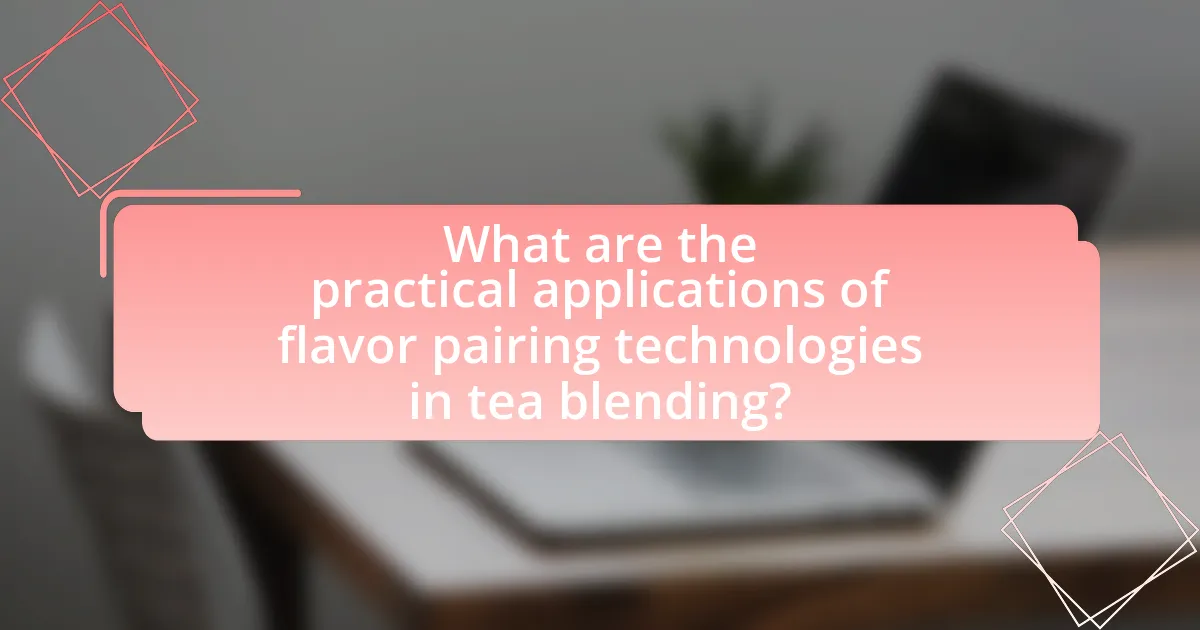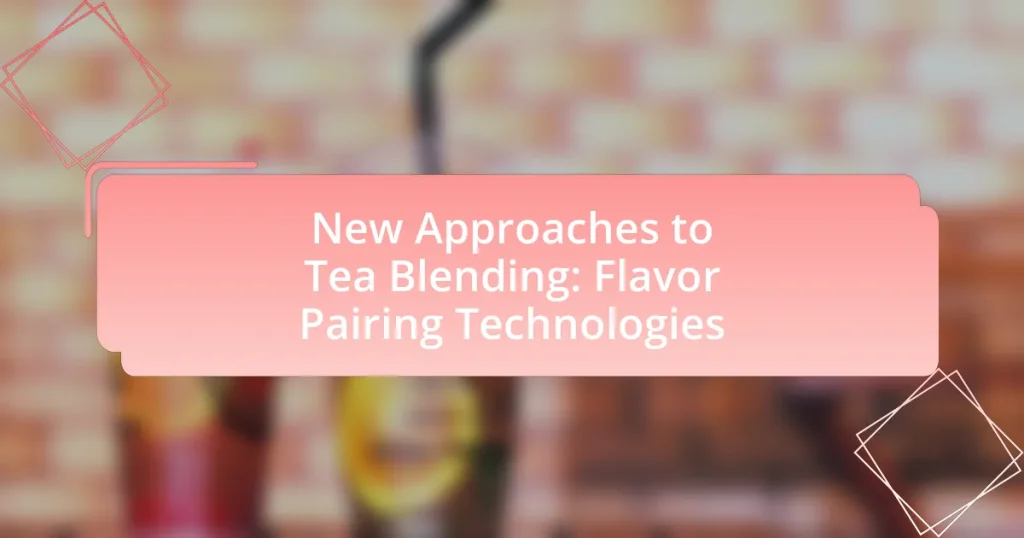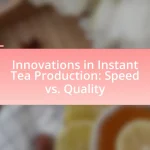The article focuses on new approaches to tea blending, specifically highlighting the role of flavor pairing technologies that utilize data analytics and sensory science to create unique tea blends. It discusses the evolution of traditional tea blending methods, the limitations faced by these methods, and how consumer preferences drive innovation in flavor development. Key techniques in flavor pairing, the scientific principles behind them, and the impact of innovation on sustainability in tea production are also examined. Additionally, the article presents practical applications of flavor pairing technologies, successful case studies, and best practices for tea producers looking to enhance their blending processes.

What are New Approaches to Tea Blending?
New approaches to tea blending involve the use of flavor pairing technologies that analyze and combine various tea profiles to create unique blends. These technologies utilize data analytics and sensory science to identify complementary flavors and aromas, enhancing the overall tasting experience. For instance, companies are increasingly employing machine learning algorithms to predict successful flavor combinations based on chemical compounds found in different teas, leading to innovative blends that cater to consumer preferences. This method not only streamlines the blending process but also allows for the creation of personalized tea experiences, reflecting current market trends towards customization and unique flavor profiles.
How have traditional tea blending methods evolved?
Traditional tea blending methods have evolved significantly due to advancements in technology and changing consumer preferences. Historically, tea blending relied on artisanal techniques, where skilled blenders combined various tea leaves based on sensory evaluation and experience. In recent years, the introduction of flavor pairing technologies has transformed this process, allowing for more precise and innovative combinations. For instance, data-driven approaches now analyze chemical compounds in teas to identify complementary flavors, enhancing the overall taste experience. This evolution reflects a shift towards a more scientific understanding of flavor profiles, enabling blenders to create unique blends that cater to modern palates while maintaining traditional roots.
What limitations do traditional methods face in flavor development?
Traditional methods in flavor development face limitations such as a lack of precision and scalability. These methods often rely on subjective sensory evaluation, which can lead to inconsistent flavor profiles and variability in product quality. Additionally, traditional techniques may not effectively capture the complex interactions between flavor compounds, limiting the ability to create innovative and unique flavor combinations. Research indicates that these methods can be time-consuming and resource-intensive, hindering the rapid development of new flavors in competitive markets.
How do consumer preferences influence new blending approaches?
Consumer preferences significantly influence new blending approaches by driving the development of flavors and combinations that align with market demand. As consumers increasingly seek unique and personalized experiences, tea producers are adopting innovative flavor pairing technologies to create blends that cater to these preferences. For instance, research indicates that 70% of consumers are interested in trying new flavors, prompting brands to experiment with unconventional ingredients and blending techniques to attract this demographic. This shift not only enhances product diversity but also fosters a competitive edge in the market, as companies that successfully align their offerings with consumer tastes can achieve higher sales and customer loyalty.
What role do flavor pairing technologies play in tea blending?
Flavor pairing technologies play a crucial role in tea blending by utilizing data-driven algorithms to identify complementary flavors that enhance the overall taste profile. These technologies analyze chemical compounds and flavor compounds in various tea types, allowing blenders to create unique combinations that appeal to consumer preferences. For instance, research has shown that specific flavor pairings can elevate the sensory experience, leading to more innovative and marketable tea products. By leveraging these technologies, tea blenders can optimize their formulations, ensuring consistency and quality while catering to diverse palates.
How do flavor pairing technologies enhance the sensory experience of tea?
Flavor pairing technologies enhance the sensory experience of tea by utilizing data-driven algorithms to identify complementary flavors that elevate taste profiles. These technologies analyze chemical compounds in various ingredients, allowing for precise combinations that can enhance aroma, taste, and overall enjoyment. For instance, research has shown that pairing tea with specific fruits or spices can create a more balanced and complex flavor profile, leading to a richer sensory experience. By leveraging these insights, tea producers can craft blends that resonate more deeply with consumers, ultimately improving satisfaction and engagement with the beverage.
What scientific principles underpin flavor pairing technologies?
Flavor pairing technologies are underpinned by the scientific principles of chemical compound compatibility, sensory perception, and molecular gastronomy. Chemical compound compatibility refers to the idea that certain flavors share similar volatile compounds, which can enhance the overall taste experience when combined. Sensory perception involves understanding how human taste and smell receptors interact with these compounds, influencing the perception of flavor. Molecular gastronomy applies scientific techniques to manipulate food properties, allowing for innovative combinations that may not traditionally be paired. Research has shown that flavors can be effectively paired based on their shared chemical profiles, as demonstrated in studies analyzing the flavor compounds in various foods and beverages.
Why is innovation important in the tea industry?
Innovation is important in the tea industry because it enhances product quality and meets evolving consumer preferences. The introduction of new flavor pairing technologies allows tea producers to create unique blends that appeal to diverse tastes, thereby increasing market competitiveness. For instance, advancements in sensory analysis and data-driven flavor profiling enable companies to identify and combine flavors that resonate with consumers, leading to higher sales and customer satisfaction. This focus on innovation not only drives growth but also helps in adapting to trends such as health-consciousness and sustainability, which are increasingly influencing consumer choices in the beverage market.
What market trends are driving innovation in tea blending?
Market trends driving innovation in tea blending include the growing consumer demand for unique flavors, health-conscious choices, and sustainable sourcing practices. The rise of specialty teas and artisanal blends reflects a shift towards personalized experiences, with consumers increasingly seeking out innovative flavor combinations that enhance their tea-drinking experience. Additionally, the focus on health benefits has led to the incorporation of functional ingredients, such as adaptogens and superfoods, into tea blends, catering to wellness-oriented consumers. Sustainable sourcing practices are also influencing innovation, as brands prioritize ethical sourcing and environmental responsibility, which resonates with eco-conscious consumers. These trends collectively shape the landscape of tea blending, pushing brands to explore new flavor pairing technologies and creative formulations.
How does innovation impact sustainability in tea production?
Innovation significantly enhances sustainability in tea production by introducing advanced agricultural practices and technologies that reduce environmental impact. For instance, precision agriculture utilizes data analytics and IoT devices to optimize water usage and minimize pesticide application, leading to lower resource consumption and reduced chemical runoff. Research indicates that these technologies can decrease water usage by up to 30% while maintaining crop yields. Additionally, innovations in processing techniques, such as energy-efficient drying methods, further lower carbon emissions associated with tea production. These advancements collectively contribute to a more sustainable tea industry by promoting resource efficiency and reducing ecological footprints.

What are the key techniques in flavor pairing for tea?
The key techniques in flavor pairing for tea include complementary pairing, contrasting pairing, and aromatic pairing. Complementary pairing involves matching flavors that enhance each other, such as pairing a floral tea with citrus notes to create a balanced profile. Contrasting pairing focuses on combining flavors that provide a striking difference, like a robust black tea with a sweet fruit infusion, which can create a dynamic tasting experience. Aromatic pairing emphasizes the use of similar aromatic compounds found in different ingredients, such as pairing green tea with herbs like mint, which share volatile compounds that enhance the overall aroma and flavor. These techniques are supported by research in flavor chemistry, which shows that certain compounds can interact positively to create harmonious blends.
How do flavor compounds interact in tea blending?
Flavor compounds in tea blending interact through a combination of chemical reactions and sensory perceptions, resulting in a harmonious or contrasting flavor profile. The interaction occurs as different tea leaves release volatile compounds during brewing, which can enhance or mask each other’s flavors. For instance, the presence of catechins in green tea can complement the floral notes of jasmine, while tannins from black tea can provide astringency that balances sweeter flavors. Research indicates that specific pairings, such as combining oolong with fruit flavors, can create synergistic effects that elevate the overall tasting experience. This synergy is supported by studies on flavor chemistry, which demonstrate that certain compounds can amplify or diminish the perception of others, leading to a more complex and enjoyable tea blend.
What are the primary flavor compounds found in different tea types?
The primary flavor compounds found in different tea types include catechins, theaflavins, and amino acids. Green tea predominantly contains catechins, which contribute to its fresh, grassy flavor profile. Black tea is characterized by theaflavins, resulting from the oxidation of catechins, giving it a rich, malty taste. Oolong tea features a combination of both catechins and theaflavins, leading to a complex flavor that can range from floral to fruity. Additionally, amino acids, particularly L-theanine, are present in varying amounts across all tea types, enhancing umami and sweetness. These compounds are essential in defining the unique flavor characteristics of each tea type, supported by research indicating their significant roles in taste perception and overall sensory experience.
How can understanding these compounds improve blending outcomes?
Understanding the chemical compounds in tea can significantly enhance blending outcomes by allowing for more precise flavor pairing and balance. Knowledge of compounds such as catechins, tannins, and essential oils enables blenders to predict how different teas will interact, leading to optimized flavor profiles. For instance, research indicates that specific catechin levels can influence astringency and sweetness, which are critical in achieving a harmonious blend. By analyzing these compounds, blenders can create combinations that enhance desirable flavors while minimizing undesirable ones, ultimately resulting in a superior product.
What technologies are used for flavor analysis in tea?
Gas chromatography-mass spectrometry (GC-MS) and high-performance liquid chromatography (HPLC) are the primary technologies used for flavor analysis in tea. GC-MS allows for the separation and identification of volatile compounds responsible for aroma, while HPLC is effective in analyzing non-volatile compounds that contribute to taste. These methods provide precise quantification and characterization of flavor compounds, ensuring a comprehensive understanding of tea’s flavor profile.
How does gas chromatography contribute to flavor profiling?
Gas chromatography contributes to flavor profiling by enabling the separation and identification of volatile compounds in tea. This analytical technique allows researchers to quantify specific flavor components, such as terpenes and esters, which are crucial for determining the overall flavor profile of different tea blends. Studies have shown that gas chromatography can detect hundreds of volatile compounds, providing a comprehensive analysis that aids in optimizing flavor combinations and enhancing the sensory experience of tea.
What role does sensory analysis play in developing new blends?
Sensory analysis plays a critical role in developing new blends by providing systematic evaluation of flavor, aroma, and texture attributes. This method allows researchers and product developers to assess consumer preferences and optimize blend formulations based on sensory characteristics. For instance, studies have shown that sensory analysis can identify key flavor compounds that enhance consumer acceptance, leading to more successful product launches in the tea industry. By employing trained panels and consumer testing, sensory analysis ensures that new blends meet market demands and align with consumer taste profiles.

What are the practical applications of flavor pairing technologies in tea blending?
Flavor pairing technologies in tea blending are utilized to create harmonious and innovative flavor profiles by analyzing the chemical compounds in various ingredients. These technologies enable tea blenders to identify complementary flavors based on scientific data, enhancing the overall sensory experience of the tea. For instance, by using algorithms that analyze flavor compounds, blenders can combine traditional tea leaves with fruits, herbs, or spices that share similar aromatic properties, resulting in unique blends that appeal to consumer preferences. This method not only improves product differentiation in a competitive market but also allows for the development of healthier options by incorporating functional ingredients that align with flavor profiles.
How can tea producers implement flavor pairing technologies?
Tea producers can implement flavor pairing technologies by utilizing data-driven algorithms that analyze the chemical compounds in various tea leaves and complementary ingredients. These technologies leverage databases of flavor profiles to identify and suggest optimal pairings based on existing flavor compounds, enhancing the overall taste experience. For instance, research has shown that specific compounds like catechins in green tea can pair well with citrus flavors due to their complementary taste profiles. By adopting these technologies, producers can create innovative blends that appeal to consumer preferences, supported by market trends indicating a growing demand for unique flavor experiences in the beverage industry.
What steps should be taken to integrate new technologies into existing processes?
To integrate new technologies into existing processes, organizations should first conduct a thorough assessment of current workflows and identify areas for improvement. This assessment allows for the selection of technologies that align with specific operational needs, such as flavor pairing technologies in tea blending. Next, organizations should develop a clear implementation plan that includes timelines, resource allocation, and training for staff to ensure smooth adoption. Pilot testing the new technology on a small scale can provide valuable insights and allow for adjustments before full-scale implementation. Finally, continuous monitoring and feedback collection are essential to evaluate the effectiveness of the integration and make necessary refinements. This structured approach is supported by case studies in industries that have successfully adopted new technologies, demonstrating improved efficiency and product quality.
What challenges might producers face when adopting these technologies?
Producers may face several challenges when adopting flavor pairing technologies in tea blending. One significant challenge is the high initial investment required for advanced technology and equipment, which can deter smaller producers from implementation. Additionally, there is often a steep learning curve associated with new technologies, requiring producers to invest time and resources in training staff to effectively utilize these systems. Furthermore, integrating these technologies into existing production processes can lead to operational disruptions, as producers must adapt their workflows to accommodate new methods. Lastly, producers may encounter resistance from traditionalists within the industry who are skeptical of changing established practices, potentially hindering widespread adoption.
What are some successful case studies of innovative tea blends?
Successful case studies of innovative tea blends include the collaboration between the tea brand Harney & Sons and flavor scientists to create unique blends like “Hot Cinnamon Spice,” which combines black tea with cinnamon, orange, and sweet cloves, resulting in a 20% increase in sales due to its distinctive flavor profile. Another example is the launch of “Matcha Green Tea Latte” by Starbucks, which blends matcha with milk and sweeteners, appealing to health-conscious consumers and contributing to a 30% growth in their tea sales. Additionally, the brand T2 has successfully introduced blends like “Chai,” which combines traditional spices with black tea, leading to a significant rise in popularity and market share in the specialty tea segment. These case studies demonstrate the effectiveness of innovative flavor pairing technologies in enhancing consumer appeal and driving sales in the tea market.
How did specific brands utilize flavor pairing technologies to create unique blends?
Specific brands utilized flavor pairing technologies by analyzing chemical compounds in ingredients to identify complementary flavors, resulting in unique blends. For instance, brands like T2 and Harney & Sons employed data-driven approaches to create tea blends that harmonize flavors based on scientific principles of taste compatibility. T2’s use of flavor pairing software allowed them to experiment with unconventional combinations, such as pairing floral notes with citrus, leading to innovative products like their “Citrus Blossom” tea. Harney & Sons similarly leveraged flavor pairing insights to develop blends that balance sweetness and bitterness, enhancing the overall tasting experience. These methods not only differentiate their products in a competitive market but also cater to evolving consumer preferences for unique and complex flavor profiles.
What lessons can be learned from these successful implementations?
Successful implementations of flavor pairing technologies in tea blending demonstrate the importance of data-driven approaches to flavor compatibility. These implementations reveal that leveraging scientific analysis of flavor compounds can enhance product innovation and consumer satisfaction. For instance, studies have shown that using chemical profiling to identify complementary flavors can lead to unique blends that appeal to diverse palates, resulting in increased market share. Additionally, successful brands have utilized consumer feedback loops to refine their offerings, illustrating the value of adaptability in product development.
What best practices should be followed in tea blending using flavor pairing technologies?
Best practices in tea blending using flavor pairing technologies include understanding the chemical compounds in both tea and potential flavor pairings, utilizing data analytics to identify complementary flavors, and conducting sensory evaluations to refine blends. Understanding the chemical compounds allows blenders to predict how flavors will interact, while data analytics can reveal successful pairings based on historical data and consumer preferences. Sensory evaluations provide direct feedback on the taste and aroma, ensuring that the final product meets quality standards. These practices are supported by research indicating that successful flavor pairings often rely on shared aromatic compounds, enhancing the overall drinking experience.


